Engineering:Minotaur I
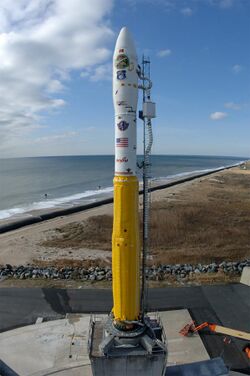 Minotaur I with NFIRE at MARS | |
| Function | Small expendable launch system |
|---|---|
| Manufacturer | Northrop Grumman |
| Country of origin | United States |
| Size | |
| Height | 19.21 metres (63.0 ft) |
| Diameter | 1.67 metres (5 ft 6 in) |
| Mass | 36,200 kilograms (79,800 lb) |
| Stages | 4 or 5 |
| Capacity | |
| Payload to LEO | 580 kilograms (1,280 lb) |
| Payload to SSO | 331 kilograms (730 lb) |
| Launch history | |
| Status | Active |
| Launch sites | Vandenberg Air Force Base SLC-8 MARS LP-0B |
| Total launches | 12 |
| Successes | 12 |
| First flight | 27 January 2000 |
| Last flight | 15 June 2021 |
| First stage – M55A1 | |
| Engines | 1 Solid |
| Thrust | 935 kilonewtons (210,000 lbf) |
| Fuel | Solid |
| Second stage – SR19 | |
| Engines | 1 Solid |
| Thrust | 268 kilonewtons (60,000 lbf) |
| Fuel | Solid |
| Third stage – Orion 50XL | |
| Engines | 1 Solid |
| Thrust | 118.2 kilonewtons (26,600 lbf) |
| Burn time | 74 seconds |
| Fuel | Solid |
| Fourth stage – Orion 38 | |
| Engines | 1 Solid |
| Thrust | 34.8 kilonewtons (7,800 lbf) |
| Burn time | 68 seconds |
| Fuel | Solid |
The Minotaur I, or just Minotaur is an American expendable launch system derived from the Minuteman II missile.[1] It is used to launch small satellites for the US Government, and is a member of the Minotaur family of rockets produced by Orbital Sciences Corporation (now Northrop Grumman).[2]
Vehicle
The Minotaur I is the follow-on to the Orbital Sciences' Taurus (later re-named the "Minotaur-C"[3]) launch vehicle, combining the original Taurus's booster stage with a second stage from a Minuteman missile.[4]
Minotaur I rockets consist of the M55A1 first stage and SR19 second stage of a decommissioned Minuteman missile.[1] The Orion 50XL and Orion 38, from the Pegasus rocket, are used as third and fourth stages. A HAPS (Hydrazine Auxiliary Propulsion System) upper stage can also be flown if greater precision is needed, or the rocket needs to be able to manoeuvre to deploy multiple payloads.[5] It can place up to 580 kilograms (1,280 lb) of payload into a 185-kilometer (115 mi) low Earth orbit at 28.5 degrees of inclination.[1]
The Minotaur I is 69 feet tall and 5 feet wide.[6]
Initially Minotaur I launches are conducted from Space Launch Complex 8 at the Vandenberg Air Force Base . Starting with the launch of TacSat-2 in December 2006, launches have also been conducted from Pad 0B at the Mid-Atlantic Regional Spaceport on Wallops Island.[5]
Launch history
There have been twelve launches of the Minotaur I, all successful.
| Flight | Date (UTC) | Payload | Launch pad | Trajectory | Result |
|---|---|---|---|---|---|
| 1 | January 27, 2000 03:03:06 |
JAWSat (P98-1) (FalconSat1 / ASUSat1 / OCSE / OPAL) | Vandenberg Air Force Base SLC-8 | LEO | Success[7] |
| 2 | July 19, 2000 20:09:00 |
MightySat II.1 (Sindri, P99-1) / MEMS 2A / MEMS 2B | Vandenberg SLC-8 | LEO | Success[8] |
| 3 | April 11, 2005 13:35:00 |
XSS-11 |  Vandenberg SLC-8 |
LEO | Success[9] |
| 4 | September 23, 2005 02:24:00 |
Streak (STP-R1) | 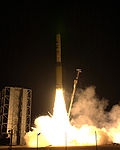 Vandenberg SLC-8 |
LEO | Success[10] |
| 5 | April 15, 2006 01:40:00 |
COSMIC (FORMOSAT-3) | Vandenberg SLC-8 | LEO | Success[11] |
| 6 | December 16, 2006 12:00 |
TacSat-2 / GeneSat-1 | 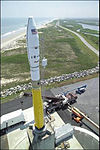 MARS LP-0B |
LEO | Success[12] |
| 7 | April 24, 2007 06:48 |
NFIRE |  MARS LP-0B |
LEO | Success[13] |
| 8 | May 19, 2009 23:55 |
TacSat-3 |  MARS LP-0B |
LEO | Success[14] |
| 9 | February 6, 2011 12:26 |
USA-225 (NROL-66) | 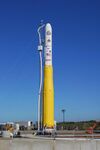 Vandenberg SLC-8 |
LEO | Success[15] |
| 10 | June 30, 2011 03:09 |
ORS-1 | 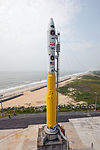 MARS LP-0B |
LEO | Success[16] |
| 11 | November 20, 2013 01:15 |
ORS-3,[17] STPSat-3 and 28 CubeSat satellites[18] |  MARS LP-0B |
LEO | Success[19] |
| 12 | June 15, 2021 13:35 |
NROL-111 | MARS LP-0B | LEO | Success[20] |
See also
References
- ↑ Jump up to: 1.0 1.1 1.2 "Minotaur I Space Launch Vehicle—Fact Sheet". Orbital Sciences. NASA. 2006. https://www.nasa.gov/centers/wallops/pdf/326336main_Minotaur_I_Fact.pdf.
- ↑ "Minotaur Rocket" (in en-US). https://www.northropgrumman.com/space/minotaur-rocket.
- ↑ Clark, Stephen (24 February 2014). "Taurus rocket on the market with new name, upgrades". Spaceflight Now. http://spaceflightnow.com/news/n1402/24minotaurc/.
- ↑ "Minotaur I Space Launch Vehicle". 2006. https://www.nasa.gov/pdf/164059main_Minotaur_I_Fact.pdf.
- ↑ Jump up to: 5.0 5.1 "Minotaur I User's Guide - Release 3.0". Orbital Sciences Corporation. http://www.orbitalatk.com/flight-systems/space-launch-vehicles/minotaur/docs/MinotaurI_UG.pdf.
- ↑ "NASA - TacSat-2 Mission Information" (in en). https://www.nasa.gov/centers/wallops/missions/tacsat2.html.
- ↑ Ray, Justin. "Spaceflight Now - Minotaur Mission Report - Mission Status Center - JAWSAT". http://www.spaceflightnow.com/osp/jawsat/status.html.
- ↑ Ray, Justin. "Spaceflight Now - Minotaur Mission Report - Mission Status Center - Mightysat 2.1". http://www.spaceflightnow.com/osp/msat2.1/status.html.
- ↑ Ray, Justin. "Minotaur rocket launches U.S. military spacecraft". Spaceflight Now. http://www.spaceflightnow.com/minotaur/xss11/.
- ↑ Ray, Justin. "Rocket launch paints sky with breath-taking scene". Spaceflight Now. http://www.spaceflightnow.com/minotaur/stpr1/.
- ↑ Ray, Justin. "Spaceflight Now - Minotaur Mission Report - Mission Status Center - COSMIC". Spaceflight Now. http://www.spaceflightnow.com/minotaur/cosmic/status.html.
- ↑ Clark, Stephen. "Minotaur rocket makes sunrise ascent from Virginia". Spaceflight Now. http://www.spaceflightnow.com/minotaur/tacsat2/.
- ↑ Ray, Justin. "Missile research spacecraft soars into orbit from Virginia". Spaceflight Now. http://www.spaceflightnow.com/minotaur/nfire/.
- ↑ Clark, Stephen. "Minotaur lofts experimental satellite for U.S. military". Spaceflight Now. http://www.spaceflightnow.com/minotaur/tacsat3/.
- ↑ "Orbital Successfully Launches Minotaur I Rocket for U.S. Air Force". Orbital Sciences Corporation. http://www.orbital.com/NewsInfo/release.asp?prid=763.
- ↑ "Orbital Successfully Launches Minotaur I Rocket Carrying ORS-1 Satellite for the U.S. Air Force". Orbital Sciences Corporation. http://www.orbital.com/NewsInfo/release.asp?prid=777.
- ↑ "Media Accreditation Open for ORS-3 Mission from Wallops in November". NASA. 30 October 2013. http://www.nasa.gov/press/2013/october/media-accreditation-open-for-ors-3-mission-from-wallops-in-november.
- ↑ "Orbital's Minotaur I successfully lofts multitude of payloads". NASASpaceFlight.com. 19 November 2013. http://www.nasaspaceflight.com/2013/11/orbital-minotaur-1-multitude-payloads/.
- ↑ "Orbital Successfully Launches Minotaur I Rocket Supporting ORS-3 Mission for the U.S. Air Force". Wall Street Journal. https://online.wsj.com/article/PR-CO-20131119-914856.html?dsk=y.
- ↑ "Northrop Grumman Successfully Launches Minotaur I Rocket for the National Reconnaissance Office". Northrop Grumman. 15 June 2021. https://news.northropgrumman.com/news/releases/northrop-grumman-successfully-launches-minotaur-i-rocket-for-the-national-reconnaissance-office.
- "Fact Sheet". Minotaur I. Orbital Sciences Corporation. http://www.orbital.com/NewsInfo/Publications/Minotaur_I_Fact.pdf.
- "Minotaur Mission History". Minotaur I. Orbital Sciences Corporation. http://www.orbital.com/SpaceLaunch/Minotaur/I/minotaur_history.shtml.
- "Minotaur I Users Guide". Minotaur I. Orbital Sciences Corporation. http://www.orbitalatk.com/flight-systems/space-launch-vehicles/minotaur/docs/MinotaurI_UG.pdf.
- Wade, Mark. "Minotaur". Encyclopedia Astronautica. http://www.astronautix.com/lvs/minotaur.htm.
- Krebs, Gunter. "Minotaur-1 (OSP-SLV)". Gunter's Space Page. http://space.skyrocket.de/doc_lau/minotaur-1.htm.
- Krebs, Gunter. "Minotaur-1 (OSP-SLV)". Gunter's Space Page. http://space.skyrocket.de/doc_lau_det/minotaur-1.htm.
- Krebs, Gunter. "Minotaur-1 HAPS (OSP-SLV)". Gunter's Space Page. http://space.skyrocket.de/doc_lau_det/minotaur-1_haps.htm.
 |

